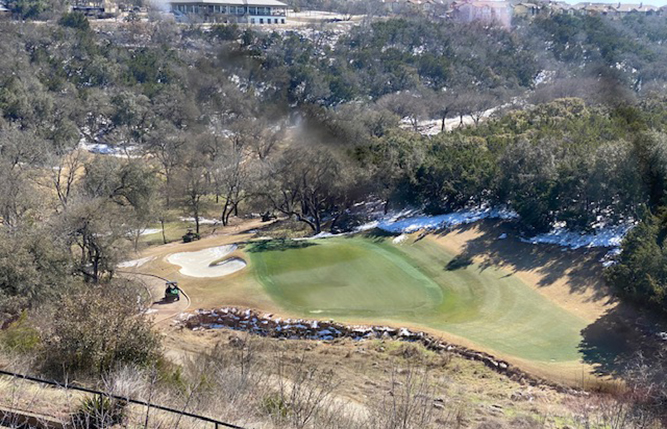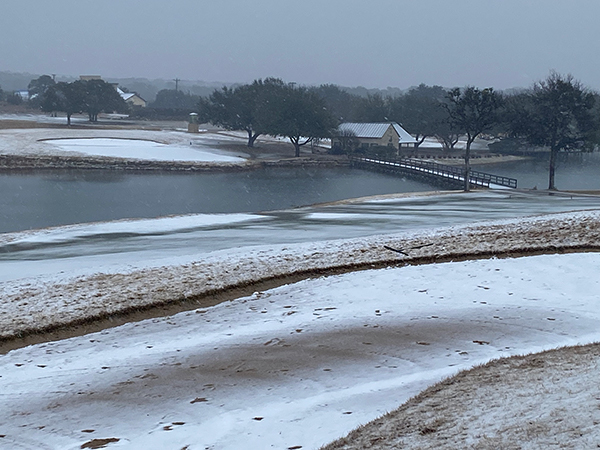February Texas deep freeze might be suppressing bugs this summer

Twin Creeks Country Club near Austin survived February’s deep freeze with no turf loss, despite 170 hours spent below freezing. (Photo: Stephen Karsh)
Vaaler Creek Golf Club Superintendent Todd Leist lost 1,500 square feet of turf in February when a Winter Storm Uri dropped temperatures in the Texas Hill Country to the single digits. The silver lining? Bugs haven’t been as big of a problem this year.
“Normally, (in) my shop area, the wash bay lights stay on 24/7, and they’d just be covered in bugs,” Leist said. “This year, I could have counted on my hands how many bugs we saw.”

Todd Leist
The hard freeze allowed him to delay his spring pesticide application until May because Leist said he wasn’t seeing the bug activity he usually expects in April. It doesn’t make up for the damage done to his No. 4 green, but it’s something.
“It’s a very undulated green and has north-facing slopes. Unfortunately, the snow that we had was a very dry snow. When the snow fell, it was so dry that a lot of it blew off of the north-facing slopes, especially on that green, so that’s where we got a lot of winter kill,” Leist said, adding that he doesn’t have an on-site nursery and the sod farms in Texas lost much of their turf to the weather, so he’s had to sacrifice portions of his putting green to fill in damaged turf.
Across the state, superintendents said the massive storm that froze portions of Texas for nearly a week is controlling the bugs a bit this summer.

Vaaler Creek CC in the Texas Hill Country got 12 inches of snow in February (Photo: Vaaler Creek).
Karsh said he didn’t lose any turf, despite hitting lows of 2 degrees F for three consecutive days. With roads impassable and power out at home, he spent much of the freeze obsessively checking his online weather station using his iPhone. He covered his greens before the storm hit, and the lowest soil temperature he read was 36 degrees F.
“We spent 170 hours below freezing. That doesn’t happen around here,” Karsh said.
In the southernmost portions of the state, along the border with Mexico, conditions didn’t get below freezing for more than a few hours, so the courses made it through healthy, but there was still widespread environmental damage, said Patrick Affolder, superintendent of the McAllen CC in the Rio Grande Valley, about 15 miles north of Reynosa, Mexico.
“We lost a lot of palm trees down here,” Affolder said. “Big mature trees too. In my neighborhood, we had some 20-, 30-year-old trees that are gone.”
He added that McAllen, Texas’ climate is surprisingly harsh on bugs. Despite hot, sometimes humid conditions, he has fewer problems there than he had in Florida and Austin with many pests. Still, he’s noticed a significant decline this year.
“I sprayed one pesticide application this year, and that was for fire ants, and they weren’t nearly as bad as usual,” Affolder said. “We usually don’t need more than two or three applications all year, but one is really low for us.”
John Walker, south central regional representative for the Golf Course Superintendents Association of America (GCSAA) and a former Texas superintendent, said he hasn’t been talking to course managers about the freeze’s impact on bugs, but he said the superintendents’ experiences make a lot of sense given the length and severity of the weather in February.
“There was a lot of turf loss across Texas and Oklahoma. This was an incredible weather event,” Walker said.
If it’s resulting in fewer bugs now, at least that’s a silver lining to February’s dark clouds, he added.












